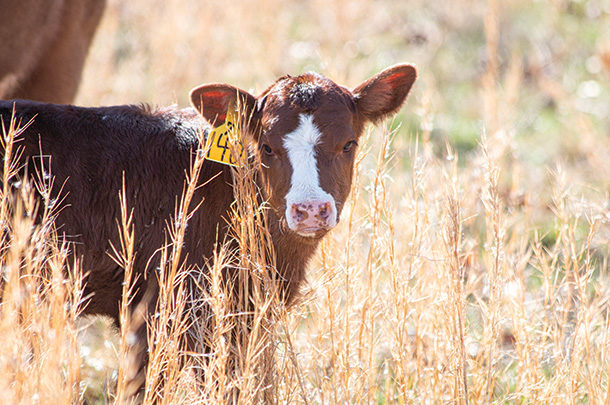It’s often said that agriculture and the livestock industry are slow to change. This may be partially true, but they are transforming themselves, nonetheless. No one knows where they will end up, but when the veil lifts decades and centuries into the future, the question might arise – will the stage be familiar or unrecognizable?
For beef cow-calf programs, Karl Hoppe, livestock systems specialist at the Carrington Research Extension Center – North Dakota State University, believes the grass-based herd is here to stay, at least as long as grass is available. “Once our demand for beef gets higher than what the grass-state system will allow, then I can see where we might go more into confinement and start raising them that way.”
He says beef cattle are forage-, not grain-based, even though most of the finishing world is grain-centered. “Since this is the case, I don’t see that movement happening. Are we going to see our herds commercialized like the swine industry? We’ve already been there for 50 years, and right now we have huge yards feeding 10 to 20 thousand head and small ones of 50 to 100 head. We also have farmers filling niches raising their own grain to feed their cattle.”
Managing all the resources
According to Trey Patterson, chief operating officer of the Padlock Ranch in Wyoming, for the ranching sector to be successful in the future, it’s important to understand the key resources needing management. In a Podbean Casual Cattle Conversations podcast earlier this year, he explained to host Shaye Koester how it all begins with having excellent people in ranching and livestock operations working as a team to understand the vision, expectations and destination of individual companies and the industry as a whole.
Next, understanding and identifying resources such as land bases, forage, water and livestock is critical.
“It’s essential to look at ranching from a systems standpoint and not get trapped seeing only its individual components. I think that’s true in our diversified operation [Padlock Ranch], but it’s also true on a family-owned cow-calf operation. Looking at all those resources and how they’re interrelated, decisions we make today affect multiple aspects of the business – not only financial, but the human component, the rangeland and the soils. We have to understand their impacts will trickle down through all those different aspects.”
Digging deeper for answers
Patterson says many determinations are made using the “it’s the way we’ve done it on tradition” theme, especially when it comes to logistics. Often, actions are based on timing and conditions. Calving seasons are decided and calendar dates when pairs are moved to pasture are examples of bowing to logistics.
“Whatever the reason, they are important, but one thing I’ve learned is we can’t let logistics kill a good idea. Be a creative thinker and think big. Open our minds to let ideas develop, and we’ll figure out the logistical considerations later.”
For a practical example, he described a ranch experiencing poor reproduction rates in their young females. Patterson urges proactivity rather than reactivity in the potential choices to address the issue.
“Try to think back in time and further into the future simultaneously. Reactionary is ‘we didn’t feed them enough last winter, so we throw more dollars at them.’ Sometimes, this may be the issue, but more often, it’s something else. Could it be the grazing plan and the timing of pasture rotation or the start of the breeding season? If it’s a range management issue, throwing more inputs at it this winter may not solve the problem. Maybe something happened to the cows when the calves were in utero, like overly tough weather that stressed them.”
Patterson also credits data and trends to help the industry be more successful in the future.
An example would be a drought season triggering a need to cull animals. On the Padlock Ranch, rather than loading the first 100 onto the truck, they would consider data such as year of birth. Since they calve at a certain time then grow the cattle and later fatten and finish them, they wouldn’t be worried about 2020 or even 2021, as 2022 is when the calves from the culled cows would be marketed.
“There are reasons why we do what we do. And we need to understand how this is going to affect us now but also down the road. Use data from internal and external information to make the best decisions at the time.”
Connecting economics with ranching ecology
Dallas Mount of Wyoming-based Ranch Management Consultants (RMC) believes that with ranches dependent on grass and livestock, understanding how they connect with economics is vital. “We can think of the ecology side as the engine running the business, so we want to keep special oil in it, tune it up and keep it running at top performance. When we get good at grazing management, we’re making sure the engine is running at its absolute best with the cows as the combine harvesting the production.”
He says too often we focus most of our energy and time on the animals and don’t pay enough attention to the ecology below, such as the grass, the microbes in the soil and the way the pieces relate to one another.
Mount doesn’t offer prescriptions to long-term success but says tools are available for planning, both economically and financially, to provide profitability into the future.
“It’s very much a 100 percent ownership type of attitude. There’s no use talking about what we don’t have any direct control of. But we do have control over what we’re going to do about it. How will we position ourselves to be successful despite these obstacles?”
Patterson agrees. “Understand in the ranching industry that we put ourselves in this situation, whatever it may be. Be humble and a lifelong learner. Get good people, advisors and resources to call and bounce ideas off of. There’s always something to learn. We’ve got to strive for continual improvement and constantly try to get better to be successful in the ranching industry.”








